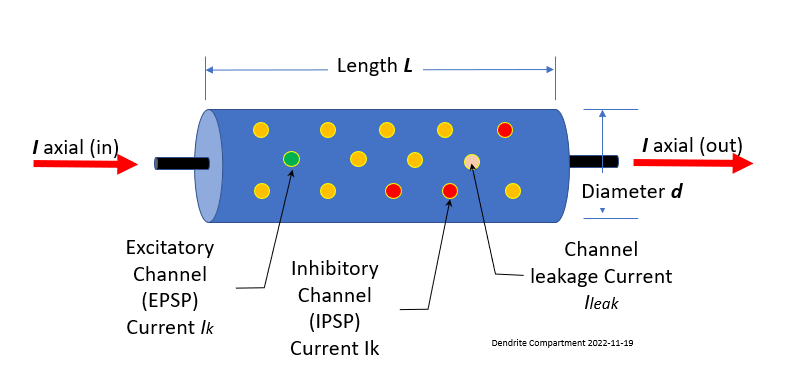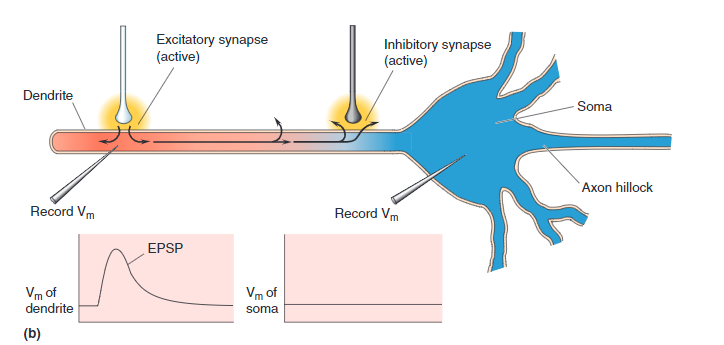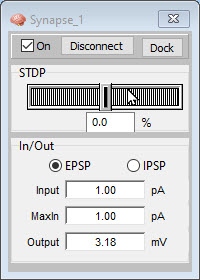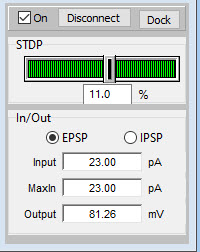Synapse

Google Search of SETI Net
Synapses
The connection between two neurons is called a synapse. Since each neuron can connect to thousands of other neurons, each neuron can have many thousands of synaptic connections.
Synapses are physically at the tip of the Dendrite. This is the location where the pulse of chemicals, the action potential, is converted into the release of neurotransmitters. The Synapse membrane is less than 50 nanometers away and contains specialized receptors. The neurotransmitter rapidly (in microseconds) diffuses across the synaptic cleft and binds to specific receptors.
The type of neurotransmitter released from the terminal and the specific receptors present on the synapse are critical in determining the quality and intensity of information transmitted by neurons.
Excited and Depressed Dendrites
There are two radio buttons labeled EPSP and ISPS. If IPSP is set, the synapse acts as an Inhibitory Postsynaptic Potential input to the dendrite cell.[kandel page 275 *] . If EPSP is set, the synapse is assumed to be connected to an EPSP synapse. These are visualized in the following image.

Connections from other neurons Axons may be attached to any one of thousands of places along the dendritic tree. The drawing of a compartment of dendrite (above) shows two types of ion channel connections:
- EPSP, Green - If the connected ion channel stimulates the soma, it is called Excitatory Post-Synaptic Potential
- IPSP, Red - If the connection channel depresses the downstream soma from firing it is called an Inhibitory Post-Synaptic Potential .
Each of these are connected through synapse. Leak channels shown in Orange are never connected.
EPSP Activated

IPSP Activated

This shows Step1 connected to an Inhibitory (IPSP) channel on Dendrite compartment 1. Step 4 is connected to an EPSP channel.
A single synapse contributes to the postsynaptic neuron's membrane potential, although the magnitude of this contribution depends on several factors:
- Synaptic Type (Excitatory or Inhibitory)
- Synaptic Current
- Membrane time and Space Constants
- Synapse location on the Dendritic Tree
- Temporal Factors ( decay and summation)
It works out that a single synaptic event moves the Dendrite membrane level about 3.24 mV
The Neuron Lab simulator does not simulate to the level of the synapse neurotransmitters. In this simulator, the synapses' role is in support of the phenomenon of Spike Timing Delay Plasticity (STDP), which is described in the section on STDP.
The Simulator
If you right-click on a Synapse icon, you will be presented with the internal workings of the Synapse. This Synapse is receiving 1 pico Amp at its input and producing 3.18 millivolts at its output to the following dendrite.

This 3.18 mV output is the maximum output for a single synaptic connection. If you wanted to simulate raising the Dendrites membrane to be enough to trigger an output from a following Soma (depolarizing from -60 mV to -40 mV), you would have to connect eight different synapses. To facilitate a more reasonable connection setup, the simulator allows higher input currents. For example:

This example has the same effect as 23 different Synaptic connections.
You may choose either method during the simulation.
The slider adjusts the effect of the synaptic inputs by a percentage. This slider is automatically set during calculations of STDP. It shows the amount of boost or buck applied to this synapse. You can disable the STDP function from the main menu.
To be biologically plausible, only a single Axon could only connect to a single Synapse input, and a single Synapse output could only connect to the single Dendrite. The simulator relaxes these rules by allowing any number of connections.
